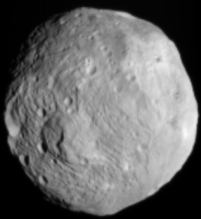
September Editorial
Hydrated minerals on Asteroid Vesta

September Editorial
Hydrated minerals on Asteroid Vesta
|
At over 500 km in diameter, the asteroid Vesta is one of the largest non-planetary objects in the solar system. In fact the asteroid formally known as 4 Vesta comes just behind the dwarf planet Ceres in size and by itself makes up an estimated 9% of the mass of the asteroid belt. Being the brightest asteroid visible from Earth 4 Vesta was quickly discovered by early astronomers. More than two centuries ago, on March 29,1807 Heinrich Wilhelm Olbers made the discovery. Like Ceres and Juno, discovered at around the same time, Vesta was named after a Roman goddess, in this case the goddess of hearth and home.
|
On the 16th of July 2011 NASA’s inquiry as to exactly what was at home on Vesta itself went into the discovery phase as the spacecraft Dawn entered into orbit around the asteroid for a one-year survey. The spacecraft left Vesta at the beginning of this month (September 5), so the data have now been collected and the process of analysis is under way. The mission was designed to help researchers understand the evolution of this massive asteroid, and Dawn has added much new information. The mission also confirmed what is already known about this giant asteroid from meteorites found on Earth which are thought to have originated from Vesta. (The meteorites in question are known as HED meteorites. ‘HED’ stands for howardite-eucrite-diogenite and are a subgroup of achondrite meteorites.) |
|
|
Achondrites are stony meteorites that do not contain chondrules - small, roughly spherical objects that formed in the solar nebula. Therefore achrondrites look similar to terrestrial igneous rocks with a low silica content. Most were formed by various melting and crystallization processes within asteroids. HED meteorites constitute about ? of all achondrites. There are three types of HED meteorites and the differences between the three is explained by differences in the geological histories of the parent rock. To judge from the radioisotope ratios, HED meteorites were crystallized about 4.43-4.55 billion years ago. Some of the data collected by the Dawn spacecraft were recently published in the journal Science. A research group led by Thomas Prettyman (ref 1), the lead scientist for Dawn’s gamma ray and neutron detector at the Planetary Science Institute in Tuscon, Arizona, tested models of Vesta’s evolution based on evidence from HED Meteorites. The researchers found that the global iron to oxygen (Fe/O) and iron to silicon (Fe/Si) ratios on Vesta are consistent with HED compositions, confirming that HED meteorites originated from Vesta. They also found that Vesta’s regolith (the layer of rock and mineral fragments that rests on bedrock and is produced by the weathering of rocks) contains large amounts of hydrogen. The highest hydrogen concentrations were in the older regions near the equator, where water ice is unstable. On the other hand the young Rheasilvia basin contained the least hydrogen. The researchers believe that the differences in hydrogen concentration are consistent with the gradual accumulation of hydrogen by infall of carbonaceous chondrites and the subsequent removal or burial of this material by large impacts. As Prettyman explains: "The source of the hydrogen within Vesta's surface appears to be hydrated minerals delivered by carbon-rich space rocks that collided with Vesta at speeds slow enough to preserve their volatile content". The adjacent paper published in the same issue of Science (ref 2) , describes how the pothole-like features visible on Vesta were probably created by volatile content, quite probably water released from hydrated minerals. The pitted terrain on Vesta, revealed in images from the Dawn spacecraft, were investigated by a team led by Brett Denevi, a Dawn participating scientist based at the Johns Hopkins University Applied Physics Laboratory in Laurel, Maryland,USA. The 'pot-holes' are irregular rimless depressions found in and around impact craters. Numerous similar structures have been seen close to numerous Martian craters, where pits are thought to form through the degassing of volatile-bearing material - mainly water- heated by the impact which caused the crater. At first scientists hoped that water ice might possibly also survive in the polar region of Vesta, but unfortunately (unlike, for example, our Moon), Vesta has no permanently shadowed polar regions where ice might survive. So the evidence for water on Vesta is mainly the presence of hydrogen and the characteristic morphology. However the investigating scientists believe that at some stage in Vesta’s history other space rocks crashed into the hydrogen-rich deposits at high speed. The collisions converted the hydrogen bound to the minerals into water. Due to the immense heat generated by the collision, the water then evaporated. "The pits look just like features seen on Mars, but while water was common on Mars, it was totally unexpected on Vesta in these high abundances," said Denevi. "These results provide evidence that not only were hydrated materials present, but they played an important role in shaping the asteroid's geology and the surface we see today." Journal Reference:
| |
| _______________________________ | ||||
| Home | | | Shopping | | | Database |
© Biscuit Software 2004-2015
All rights reserved